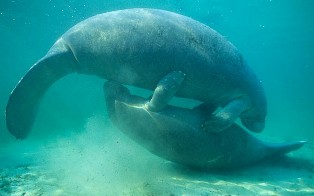Want to learn more about the West Indian Manatee? Read on for facts and info on the largest surviving mammal in the aquatic world…
The West Indian manatee also known by its biological name the Trichechus manatus is the largest mammal surviving today in the aquatic world.
It is a species which is differentiated from the West African or Amazonian manatee. Genetic studies have led to its classification into two subspecies named the Caribbean and Florida Manatee. With further DNA testing and research the West Indian manatee has been subdivided into three groups which arise because of the distribution on a geographic level. The Manatee is now subdivided in northern and central South America, its home in northeastern South America and the third hailing from Florida and the region of the Greater Antilles or Caribbean.
Physical Description of the West African Manatee
The West African manatee has adapted to marine life. The pelages that cover its body lightly allow the reduction of algae on its brown or gray colored skin. On average this mammal is 3 m in length and can weigh from anywhere between 400 to 600 kg. The males are generally smaller in size when compared to the females. The largest manatee recorded was 1500 kg and measured 4.6 m in length, that’s approximately 15.2 feet- quite a large mammal for its species.
The Natural Habitat for the Manatee – Caribbean Homeland
The West Indian manatee is obviously native to the West Indies and Caribbean region and is found profusely in shallow areas around the coast. Sometimes they swim upstream into the river and estuary in the West Indian landscape. The West Indian manatees have a very slow metabolism and very thin skin lacking the layer of insulation to keep them warm. For this reason they are native to the subtropical and tropical areas of the West Indies. It is interesting to note that during the hot summer months you can spot a few of the West Indian manatee as far north as Cape Cod, Massachusetts.
Florida as a Natural Homeland for the Subspecies
The Florida manatee are by far the most widely observed creatures of the species and a lot of attention and funds have been spent on figuring out their ecological system and behavior patterns. The females give birth approximately at the age of four years and repeat every 2 to 5 years and there are even some cases in which they have given birth to twins.
The family structure consists of the mother and child which bond for up to two years. Males are not responsible for care of the young and only interact with the females during procreation. Although this mammal is on the endangered species list unfortunately their sheer size and encroachment of human beings into their ecosystem has led to dwindling numbers of the species. They are very agile and non-territorial animals termed as opportunistic feeders and consume large quantities of plants and grasses everyday. An interesting fact is that their molars are continuously replaced throughout their life because the rough foliage that they feed on tends to wear out the teeth.
They are known to survive up to the age of 60 years and unfortunately interaction with humans and encroachment into their natural habitat has led to dwindling numbers of the West Indian manatee overall with only a few more than 3000 of them surviving.





